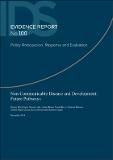| dc.contributor.author | MacGregor, Hayley | |
| dc.contributor.author | Lally, Steven | |
| dc.contributor.author | Bloom, Gerry | |
| dc.contributor.author | Davies, Mark | |
| dc.contributor.author | Henson, Spencer | |
| dc.contributor.author | Mejía Acosta, Andrés | |
| dc.contributor.author | Roelen, Keetie | |
| dc.contributor.author | Ulrichs, Martina | |
| dc.coverage.spatial | Brazil | en_GB |
| dc.coverage.spatial | Ghana | en_GB |
| dc.coverage.spatial | South Africa | en_GB |
| dc.date.accessioned | 2014-12-01T12:23:14Z | |
| dc.date.available | 2014-12-01T12:23:14Z | |
| dc.date.issued | 2014-12 | |
| dc.identifier.citation | MacGregor, H.; Lally, S.; Bloom, G.; Davies, M.; Henson, S.; Mejía Acosta, A.; Roelen, K. and Ulrichs, M. (2014) Non-Communicable Disease and Development: Future Pathways, IDS Evidence Report 100, Brighton: IDS | en_GB |
| dc.identifier.uri | https://opendocs.ids.ac.uk/opendocs/handle/20.500.12413/5271 | |
| dc.description.abstract | From a biomedical perspective, non-communicable disease (NCD) is not a new problem, particularly in the global North. However, awareness of the increasing burden from these conditions in low- and middle-income countries (L&MICs) has only recently emerged in the arena of development policy and practice (Beaglehole et al. 2011). In September 2011, the United Nations convened a summit on NCD, only the second such meeting ever to address a disease matter. However, despite a declaration reiterating the importance of NCD, few concrete actions emerged.
The focus of the meeting was only on the conditions included in the World Health Organization’s (WHO) core definition of NCD, diseases which share a defined set of individual-level risk factors and collectively constitute a substantial proportion of the disease burden: cardiovascular disease (CVD), chronic respiratory diseases, certain cancers and diabetes. Yet notwithstanding the Secretary-General’s call to bring NCD into the broader global health and development agenda, alongside growing concern about the financial and social implications of premature deaths and morbidity from these conditions, the impression persists in some quarters that NCD is not a ‘development problem’. Since some of the personal risk factors for these diseases are linked to lifestyle (in the case of the WHO core conditions, factors such as tobacco and alcohol use, physical inactivity and unhealthy diets), there is a tendency to retain a narrow medical and individual-level focus in conceptualising the problem and responses. | en_GB |
| dc.description.sponsorship | UK Department for International Development | en_GB |
| dc.language.iso | en | en_GB |
| dc.publisher | IDS | en_GB |
| dc.relation.ispartofseries | IDS Evidence Report;100 | |
| dc.rights.uri | http://creativecommons.org/licenses/by/3.0/ | en_GB |
| dc.subject | Health | en_GB |
| dc.subject | HIV/AIDS | en_GB |
| dc.subject | Nutrition | en_GB |
| dc.subject | Social Protection | en_GB |
| dc.title | Non-Communicable Disease and Development: Future Pathways | en_GB |
| dc.type | IDS Evidence Report | en_GB |
| dc.rights.holder | IDS | en_GB |
| dc.identifier.ag | OT/11009/7/1/1/247 | |


